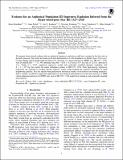| dc.contributor.author | Ezzeddine, Rana | |
| dc.contributor.author | Frebel, Anna L. | |
| dc.date.accessioned | 2020-12-03T18:33:07Z | |
| dc.date.available | 2020-12-03T18:33:07Z | |
| dc.date.issued | 2019-05 | |
| dc.date.submitted | 2019-03 | |
| dc.identifier.issn | 0004-637X | |
| dc.identifier.uri | https://hdl.handle.net/1721.1/128723 | |
| dc.description.abstract | We present observational evidence that an aspherical supernova explosion could have occurred in the first stars in the early universe. Our results are based on the first determination of a Zn abundance in a Hubble Space Telescope/Cosmic Origins Spectrograph high-resolution UV spectrum of a hyper-metal-poor (HMP) star, HE 1327-2326, with . We determine [Zn/Fe] = 0.80 ±; 0.25 from a UV Zn i line at 2138 detected at 3.4σ. Yields of a 25 M o aspherical supernova model with artificially modified densities exploding with E = 5 × 1051 erg best match the entire abundance pattern of HE 1327-2326. Such high-entropy hypernova explosions are expected to produce bipolar outflows, which could facilitate the external enrichment of small neighboring galaxies. This has already been predicted by theoretical studies of the earliest star-forming minihalos. Such a scenario would have significant implications for the chemical enrichment across the early universe, as HMP carbon-enhanced metal-poor (CEMP) stars such as HE 1327-2326 might have formed in such externally enriched environments. | en_US |
| dc.description.sponsorship | United States. National Aeronautics and Space Administration (Contract NAS 5-26555) | en_US |
| dc.language.iso | en | |
| dc.publisher | American Astronomical Society | en_US |
| dc.relation.isversionof | 10.3847/1538-4357/AB14E7 | en_US |
| dc.rights | Article is made available in accordance with the publisher's policy and may be subject to US copyright law. Please refer to the publisher's site for terms of use. | en_US |
| dc.source | The American Astronomical Society | en_US |
| dc.title | Evidence for an Aspherical Population III Supernova Explosion Inferred from the Hyper-metal-poor Star HE 1327–2326 | en_US |
| dc.type | Article | en_US |
| dc.identifier.citation | Ezzeddine, Rana et al. “Evidence for an Aspherical Population III Supernova Explosion Inferred from the Hyper-metal-poor Star HE 1327–2326.” Astrophysical Journal, 876, 2 (May 2019): 97 © 2019 The Author(s) | en_US |
| dc.contributor.department | Massachusetts Institute of Technology. Department of Physics | en_US |
| dc.relation.journal | Astrophysical Journal | en_US |
| dc.eprint.version | Final published version | en_US |
| dc.type.uri | http://purl.org/eprint/type/JournalArticle | en_US |
| eprint.status | http://purl.org/eprint/status/PeerReviewed | en_US |
| dc.date.updated | 2020-10-23T13:28:45Z | |
| dspace.orderedauthors | Ezzeddine, R; Frebel, A; Roederer, IU; Tominaga, N; Tumlinson, J; Ishigaki, M; Nomoto, K; Placco, VM; Aoki, W | en_US |
| dspace.date.submission | 2020-10-23T13:28:51Z | |
| mit.journal.volume | 876 | en_US |
| mit.journal.issue | 2 | en_US |
| mit.license | PUBLISHER_POLICY | |
| mit.metadata.status | Complete | |
